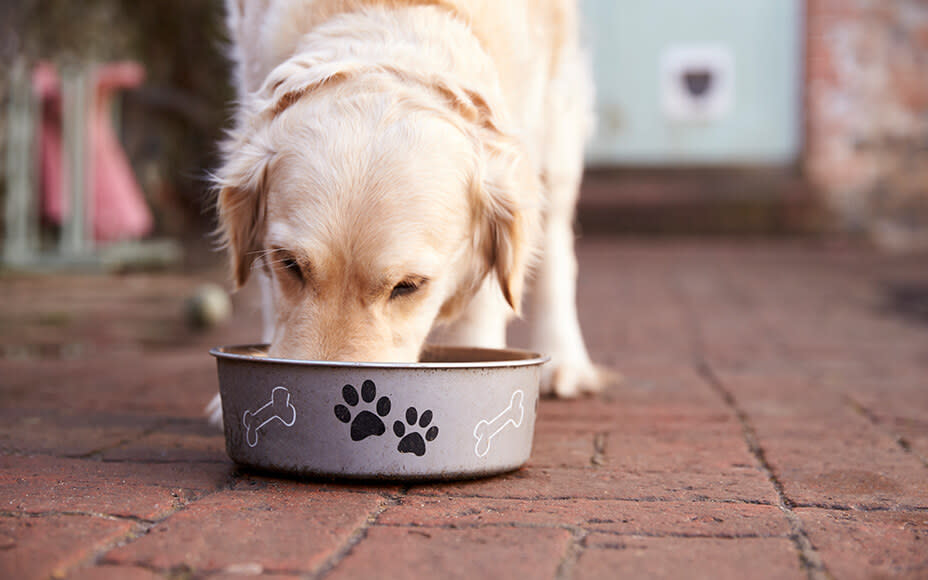Is my dog overweight, and how can I reduce its weight? What are the real culprits for pet obesity?
Tackling the Bulge: Canine Obesity
When Beagle lady Molly starts panting after the first four meters and visually lives up to her name, it’s time for you and your furry friend to grab the exercise mats. It’s time to bid farewell to those extra pounds.
Learn why obesity in dogs is more than just unhealthy, poses numerous risks to your pet’s life, and how your canine companion can regain its bikini figure.
The Four Biggest Culprits – Causes of Obesity in Pets
A half sausage from the grill, five treats in between, and Bam, Dachshund Waldi is indistinguishable from the bratwurst on the grill. But improper nutrition isn’t the only factor leading to obesity in dogs and cats. Here they are – the five biggest culprits:
1. Too Many Treats:
Undoubtedly, few can resist those sparkling dog eyes that beckon you multiple times a day with something delicious. And so, what used to be one treat easily turns into 10, contributing to excess weight on your pet’s hips.
2. Begging:
Maybe you’ve been consistent with your furry friend, and no crust has made its way under the table and into the dog’s belly. Or perhaps you can’t resist, and guilt plagues you at the dining table while your pet watches and craves a slice of ham. Much of what’s on your plate is a true contributor to your furball’s weight gain.
3. Lack of Exercise:
You’re not the only one familiar with this: neglecting regular exercise and spending days on the couch leads to weight gain. Calories consumed by your pet must be burned off, or they’ll accumulate as fat.
4. Unhealthy Diet:
Only the best for your darling? But not everything that glitters is gold. A look at the labels of conventional pet food reveals questionable ingredients, with no trace of natural nutrients. Good pet food contains a lot of high-quality meat, such as muscle meat, liver, or hearts. Additionally, it should not contain preservatives, sugar, or grains. Cheap pet food often includes fillers like grains to cut costs, but these provide too many carbohydrates that your pet can’t burn, leading to weight gain.
What Does Obesity Do to My Pet?
Aside from the fact that the physical discomfort alone can drastically limit your pet’s quality of life when it is overweight, obesity can lead to numerous diseases. These often shorten the lifespan of your four-legged friend by several years. These five problems may occur if you let the excess weight go unchecked:
- Joint Diseases: Joints, bones, tendons, and ligaments are heavily burdened by your pet’s excess weight. In the long run, this can lead to excessive wear and tear, manifesting as arthritis or hip dysplasia.
- Cardiovascular System: Excess pounds lead to issues such as high blood pressure, elevated blood lipid levels, and heart problems.
- Skin Issues Compared to normal-weight pets, the risk of changes to the skin and fur is significantly higher. With high obesity, your pet may not be able to properly clean its fur, leading to germ accumulation in skin folds.
- Diabetes: Like in humans, obesity can cause metabolic disturbances. The risk of your pet developing diabetes increases with every added kilogram. Particularly, sugary foods and pet food contribute to this risk.
- Immune System: The immune system is also affected by obesity. Fatty pets are more susceptible to infections and find it harder to recover, creating a vicious cycle.

Reducing Your Pet’s Weight: How Do I Do It?
If your pet has been dealing with obesity (for a while), a visit to the vet is advisable. In rare cases, serious illnesses may underlie weight gain, which cannot be treated by weight reduction alone. If the vet gives the green light, it’s time to tackle the bulge!
However, shedding those pounds is not as quick as putting them on. Gradually switch the food, paying attention to the reduced crude fat content in the analytical components of the dog food.
Your furry friend should lose a maximum of 2% of its body weight per week, so do not skip meals or drastically reduce the amount of food.
Preventing Obesity in Your Pet
Of course, it’s best if your pet never faces obesity. Avoid the dangerous combination of too little exercise and too much (unhealthy) food and focus on maintaining a healthy balance in these aspects.
Structured feeding times are not only important for your pet’s education but can also be useful for maintaining a healthy weight. Set two fixed meals a day, whether you feed your pet from the bowl or on the go. Also, avoid pet food containing grains, sugar, and other additives. Good food is half the battle to provide your pet with a long and healthy life.
Treats should always be factored into the daily food ration! Also, don’t reward your pet just because it’s cute; instead, demand some physical activity.
Furthermore, you can replace treats with affectionate gestures, strengthening the bond between you and your furry friend better than any chew stick.

If your furry friend is already struggling with obesity, it means stress for both of you and high veterinary costs for you. Your pet will thank you if you proactively engage with the topic of healthy pet nutrition and find the most irresistible food for it.
If you haven’t found the right food for your beloved pet and need assistance, you can consult with us for free over the phone on all questions related to pet nutrition.
Frequently Asked Questions
What to Do If Your Dog Is Overweight?
If your dog has a bit too much around the waist, it’s essential to support them in shedding those extra pounds. An overweight dog can face health consequences, but achieving and maintaining their ideal weight is not a challenge with the right food, appropriate portion sizes, and sufficient exercise. There’s also specialized diet and weight management food for dogs, which is calorie-reduced and still satisfying.
How Can a Dog Lose Weight Effectively?
Pay attention to the daily food intake, including snacks. Breeds with a big appetite are more prone to obesity. In addition to your daily walks, depending on the severity of the overweight condition, you can increase exercise by walking faster or longer. Swimming can also aid weight loss in water-loving dogs and is gentle on the joints.
How Do I Know If My Dog Is Overweight?
When palpating your dog, you should be able to feel the ribs lightly. If they are surrounded by a thick layer of fat, your dog may be overweight. Also, look at your dog from above. The figure should suggest an hourglass shape, with the waist being the narrowest part, though not excessively. If there’s no noticeable waistline, your dog likely has excess weight. Additionally, many dogs exhibit a swaying belly when walking. While it may seem normal to us, it’s actually a sign that your dog is overweight. When viewed from above, your dog’s belly should not protrude too much at the sides.
What Food Is Suitable for Overweight Dogs?
A healthy and species-appropriate diet for a dog consists of food with high-quality ingredients and no unnecessary additives like grains, sugar, or flavorings. Pay attention to the appropriate portion size, including snacks, and your dog will naturally lose weight. Additionally, you can feed specialized diet and weight management food for dogs. This is usually calorie-reduced, satisfying, and tasty.


